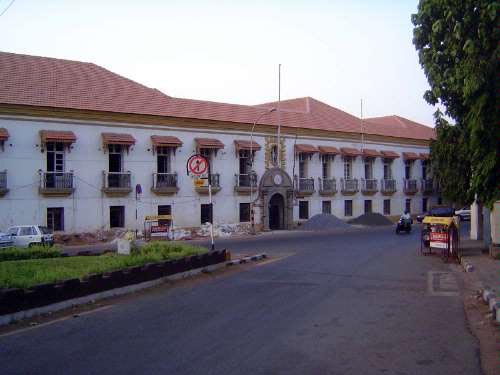Idalcao Palace

Information on Idalcao Palace (Goa) - History & Architecture
Idalcao Palace which was also known as Adil Shah Fort is regarded as one of the oldest surviving forts in Goa. The palace is situated in the capital of Goa, i.e. Panjim or Panaji at the bank of Mandovi River. Idalcao Palace was created in the year 1500 by Yusuf Adil Shah as a waterside pleasure. Later, the palace was reinvigorated and served as a strategic security point for Portuguese people. They further developed the military strength of the palace. Idalcao Palace is also regarded as the first passport office in India, where freight from overseas vessels was monitored.
Idalcao Palace Architecture
The clerical construction of Idalcao Palace is based on royal Portuguese architecture. Created by the Mughal Empire during 16th century, this palace is regarded as one of Goa's, eldest standing heritage structures. Idalcao Palace had endured multiple reforms through its survival for about 500 years. It was originally reformed by Portuguese in the year 1613 where the primary gateway was created as curved doorway on the opposite side of Mandovi River. The roof of the viceroys above the primary entrance was swapped by national symbol, i.e. the Asoka Chakra of Indian national flag. The roof of Idalcao Palace is created by red tiles which is quite unique in nature. The tiles vary with respect to size, altitude and gradient of every room inside the palace which has generated a stimulating architectural effect.
The Palace is characterised by various decorated rooms. There was a small sanctuary which was created inside the palace in the year 1760. In the year 1918, again Idalcao Palace has experienced change where a cross from the sanctuary inside the palace was shifted. The reredos of primary alter was also removed to the 'Church of Immaculate Conception' at Panaji. Its architectural brilliance is truly unique and more of all the artistic work in the decorated rooms are amazing from architectural point of view.
Idalcao Palace History
Idalcao Palace has significant history behind its existence. The name 'Idalcaon' was used a corrupted word in Portuguese. It was used against the then Mughal ruler, i.e. Adil Shah Khan who was the sultan of Bijapur. It was initially a recreational place for Adil Shah Khan. However, in the year 1510, the palace was captured by Alfonso de Albuquerque when the Portuguese ruler tumbled the Mughal emperor. Later, it was reconstructed by Portuguese viceroy named D. Jeronimo in the year 1615. Idalcao Palace was the residence of D. Jeronimo from the year 1759. In the year 1818, Panjim became the capital of Goa and thus the governor general decided to shift to Cabo promontory, also termed as Cabo raj Nivas. As a result, Idalcao Palace become a government office. After independence, the palace changed to secretariat house. Nowadays, it houses the national passport office.
Idalcao Palace Tourism Importance
As one of the oldest premises, Idalcao Palace is regarded as a popular tourism place in Goa. It was ruled by various Portuguese rulers, making the palace a worthy historical place to explore. Furthermore, the palace has lots of interesting structures with designed rooms which can be enjoyed by the travellers. The palace itself is a key specimen of 16th century architecture. It is a fine illustration of traditional Mughal design with various modifications doe by subsequent rulers. Furthermore, since it is a residential place of various viceroys, it makes the place quite interesting to visit. There are also various nearby places which can be quite attractive for travellers.
- Andaman Nicobar Monuments
- Andhra Pradesh Monuments
- Assam Monuments
- Bihar Monuments
- Chhattisgarh Monuments
- New Delhi Monuments
- Goa Monuments
- Gujarat Monuments
- Haryana Monuments
- Himachal Pradesh Monuments
- Jammu and Kashmir Monuments
- Karnataka Monuments
- Kerala Monuments
- Madhya Pradesh Monuments
- Maharashtra Monuments
- Odisha Monuments
- Punjab Monuments
- Rajasthan Monuments
- Tamil Nadu Monuments
- Telangana Monuments
- Uttar Pradesh Monuments
- West Bengal Monuments